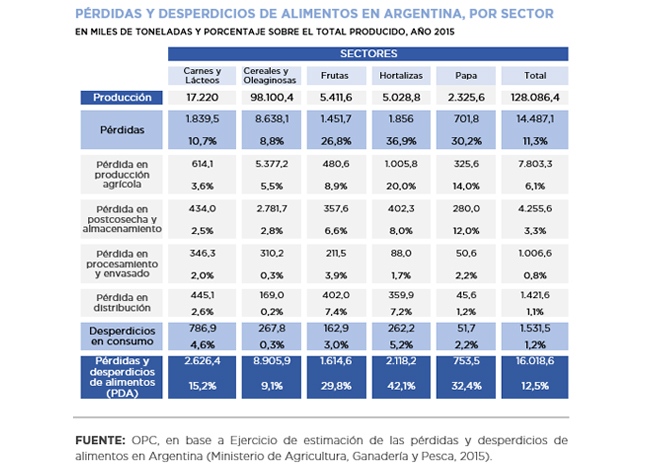
by Nicolas Perez | Jan 21, 2020 | Sustainable Development Goals
SDG 12, one of the Goals set by the United Nations to which Argentina adheres, seeks to ensure sustainable production and consumption patterns.
The country has adopted three of the eleven goals set by the UN program and the absence of methodological definitions regarding the monitoring of the reduction of food losses and waste prevents the analysis of the feasibility of the goal set. But according to a preliminary estimate with data from 2015, 16 million tons of food were lost and wasted in Argentina, from production to consumption, and the bulk of the losses were generated in the early stages of production.
According to CEAMSE, 41.5% of the metropolitan garbage is food, sometimes unconsumed. Another revealing fact of the pending tasks to achieve goals in this field is that of the 7 million tons of solid waste collected during 2018 only 12,000 have been recycled and 4,300 approximately have been composted (transformed into humus), values that indicate a setback in relation to previous years.
Direct expenditure related to SDG 12 totaled AR$790 million as of November 2019 and the accrued expenditure was 9% higher than in 2018, mainly allocated to the Program of Policies for the Increase of Productivity of Agro-industrial Chains (Ministry of Agriculture, Livestock and Fisheries). The indirect expenditure, of AR$7.16 billion, is primarily related to INTA’s research activities.
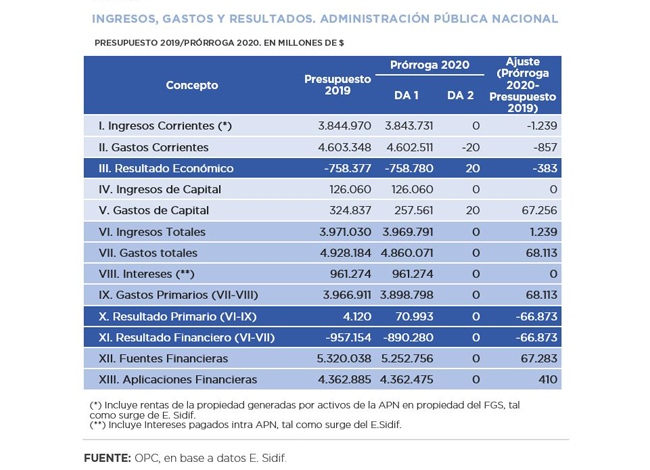
by Nicolas Perez | Jan 20, 2020 | Budget Law
The National Congress did not pass the Budget Bill prepared by the National Government for the fiscal year 2020. As a result, the Executive Branch provided for the extension of the 2019 Budget, and its respective allocations, within the new ministerial structure, but without making the adjustments in the estimation of resources and expenditures as provided for in Section 27 of the Financial Administration Law.
In accordance with Executive Order No. 4 on the extension, “the debt, economic and social crisis creates such uncertainty that prevents the immediate and precise definition of the adjustments referred to in Section 27 of Law 24,156 on Financial Administration”, empowering the Chief of Cabinet of Ministers to adjust the Budget that is being extended within the framework of that provision.
All the above is expected to be carried out until the approval of the 2020 Budget Bill to be submitted by the Executive Branch.
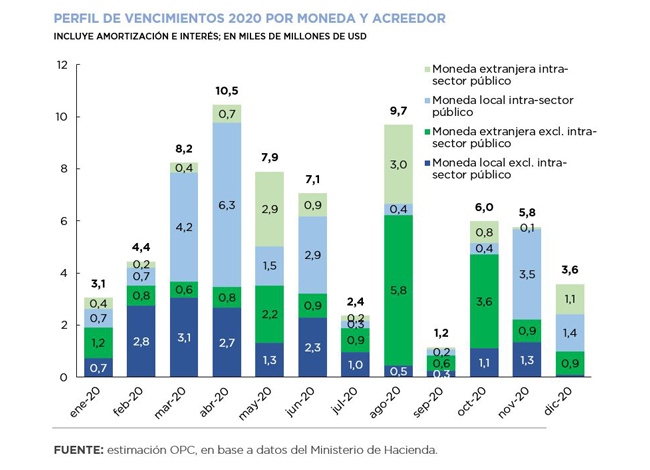
by Nicolas Perez | Jan 17, 2020 | Public Debt Operations
During December, placements of securities and loan disbursements were recorded for the equivalent of USD9.82 billion, of which USD4.84 billion were net transfers of Temporary Advances from the Central Bank (BCRA). For the first time since July 26, an auction of instruments in pesos was held, which resulted in the placement of Treasury bills for AR$37.01 billion.
In December, the National Executive Power ordered a new deferral of payments of Treasury bills in dollars until August 31, which implied a deferral of maturities for approximately USD7.47 billion.
In the first half of 2019, the Treasury was financed mainly through the placement of short-term bills, repo transactions with commercial banks and the disbursement of the International Monetary Fund. The worsening of financial conditions in the second half of the year implied the closing of the market and the search for financing in public sector entities.
The debt service maturity profile (principal and interest) for 2020 totals USD69.7 billion. However, excluding maturities within the public sector, estimated services are reduced to USD36.21 billion.
For January, debt maturities of approximately USD3.06 billion are expected between amortizations (USD1.66 billion) and interest (USD1.39 billion).
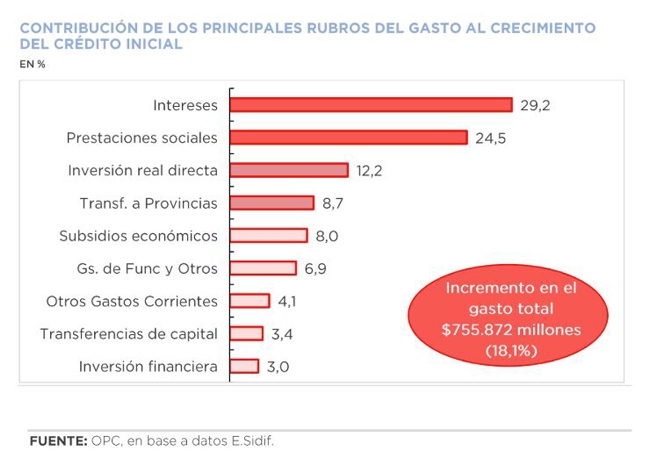
by Nicolas Perez | Jan 15, 2020 | Budget Execution
Fiscal year 2019 ended with a real increase in resources of 2.1% with respect to the previous year and with a contraction in expenditure of 6.4% YoY, spread across the main components, apart from debt interest, which increased by 10.7% YoY in real terms.
The combination of these behaviors resulted in a financial deficit of AR$845.99 billion, equivalent to 3.9% of the Gross Domestic Product, 1.7 percentage points below that of the previous year. The primary balance showed a surplus of AR$75.49 billion, an improvement compared to 2018.
The evolution of Export Duties was decisive in the increase in tax revenues, which had a real jump of 164.4% year-on-year because of the increase in tax rates, the devaluation of the exchange rate and the higher quantities exported by the soybean sector.
This scenario offset the fall in other tax items and the resources of the social security system, affected by the lower economic activity and the reduction of taxable wages.
In 2019, national government expenditure reached AR$4.74 trillion, which implies an execution level of 96.2% of the allocated budget. The initial approved appropriation increased by 18.1%, with debt interest being the item that most contributed to such variation (29.2%).
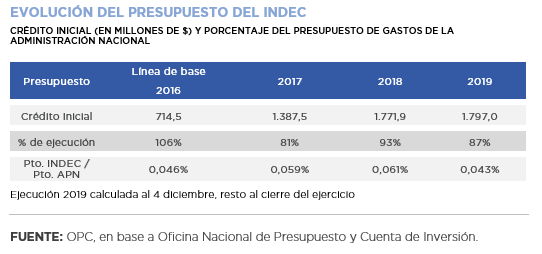
by Nicolas Perez | Jan 10, 2020 | Sustainable Development Goals
Sustainable Development Goal (SDG) number 17, “Partnerships for achieving the goals”, seeks to promote synergies between governments and civil society, both nationally and internationally, to facilitate the fulfillment of purposes set forth in the program conceived under the umbrella of the United Nations.
Argentina adopted six of the nineteen goals set by the UN relating to: technology, capacity building, multi-stakeholder partnerships and data, monitoring and accountability.
Among other global goals, this adhesion commits the country to having reliable data, providing sustainable development indicators, and increasing the population’s access to technologies such as the Internet, with definitive goals for 2030 and some others prior to that. Due to methodological issues or lack of baseline data, this monitoring is not always feasible to carry out under the required conditions.
The general analysis of the available indicators shows, among many other points, that Argentina is waiting for a new National Statistical Plan, part of a legislative bill to modernize the system developed by INDEC (National Institute of Statistics and Censuses). According to an official study conducted in 2016 with the support of UNICEF, there is a 3.8% of under-recording of births and no accurate record of all deaths, also an under implementation of the actions related to the National Plan for the eradication of gender violence in the scope of INAM (National Institute for Women).
Direct expenditure projected for 2019 totaled $3.28 billion (39% higher than in 2018) and as of November its execution was 110%.
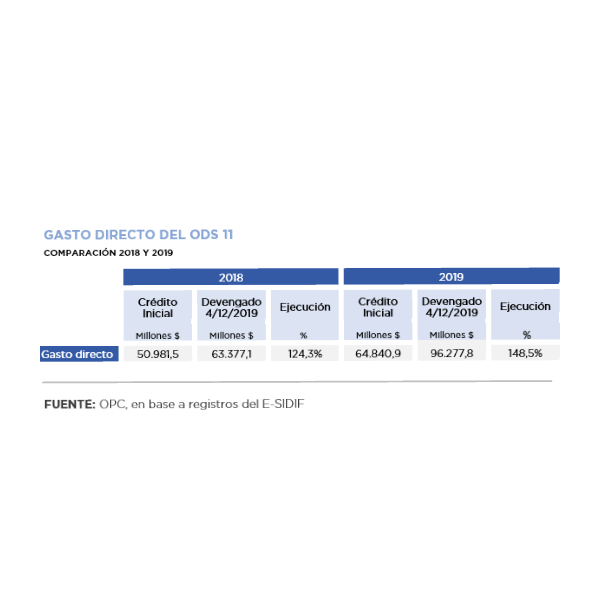
by Nicolas Perez | Jan 3, 2020 | Sustainable Development Goals
In this third OPC report on the implementation of the United Nations Sustainable Development Goals, to which Argentina adheres, SDG 11: “Sustainable Cities and Communities”, which includes aspects such as access to housing, basic services and transportation and waste management, will be analyzed.
From the budgetary analysis of SDG 11, it is identified that the direct expenditure projected for 2019 amounted to AR$64.84 billion, 27.2% higher than in 2018, in nominal terms.
Its execution as of November 2019 was 148.5%, because of the higher relative execution of capital expenditures.
By evaluating the different programs, distributed in different government departments, a significant budgetary concentration is observed in those referred to Transportation and Road Safety, which include subsidies to contain the fares and the implementation of social tariffs, items that required more than AR$26 billion during the year. Another item with an important relative allocation of funds is the improvement of railway infrastructure.
There are programs with executions above the initial Budget during 2019, such as the burying of the Sarmiento Railway and the Bicentennial Highway.
As for other goals, there are ambitious pending targets, for example, that 12 million households in the next decade will have access to public transportation within 300 meters. Similarly, to meet the goal of adequate solid waste treatment, 21,000 tons per day would have to be properly disposed of.
With respect to improving access to housing, the goal is focused on that group of the population that meets the conditions of living in inadequate housing and, at the same time, having irregular tenancy, a situation that restricts the target population of the housing policy.






